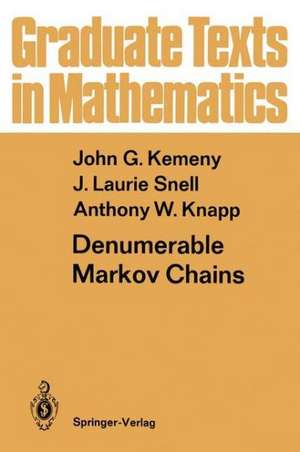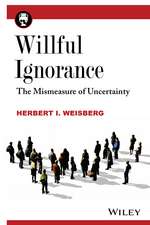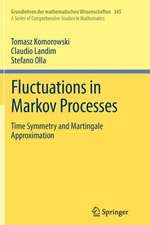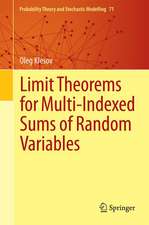Denumerable Markov Chains: with a chapter of Markov Random Fields by David Griffeath
D.S. Griffeath Autor John G. Kemeny, J. Laurie Snell, Anthony W. Knappen Limba Engleză Hardback – sep 1976
| Toate formatele și edițiile | Preț | Express |
|---|---|---|
| Paperback (1) | 499.50 lei 6-8 săpt. | |
| Springer – 12 iul 2012 | 499.50 lei 6-8 săpt. | |
| Hardback (1) | 543.85 lei 6-8 săpt. | |
| Springer – sep 1976 | 543.85 lei 6-8 săpt. |
Preț: 543.85 lei
Preț vechi: 639.82 lei
-15% Nou
Puncte Express: 816
Preț estimativ în valută:
104.08€ • 108.52$ • 86.50£
104.08€ • 108.52$ • 86.50£
Carte tipărită la comandă
Livrare economică 20 martie-03 aprilie
Preluare comenzi: 021 569.72.76
Specificații
ISBN-13: 9780387901770
ISBN-10: 0387901779
Pagini: 484
Ilustrații: XII, 484 p.
Dimensiuni: 156 x 234 x 27 mm
Greutate: 0.87 kg
Ediția:2nd ed. 1976
Editura: Springer
Colecția Springer
Locul publicării:New York, NY, United States
ISBN-10: 0387901779
Pagini: 484
Ilustrații: XII, 484 p.
Dimensiuni: 156 x 234 x 27 mm
Greutate: 0.87 kg
Ediția:2nd ed. 1976
Editura: Springer
Colecția Springer
Locul publicării:New York, NY, United States
Public țintă
ResearchCuprins
1: Prerequisites from Analysis.- 1. Denumerable Matrices.- 2. Measure Theory.- 3. Measurable Functions and Lebesgue Integration.- 4. Integration Theorems.- 5. Limit Theorems for Matrices.- 6. Some General Theorems from Analysis.- 2: Stochastic Processes.- 1. Sequence Spaces.- 2. Denumerable Stochastic Processes.- 3. Borel Fields in Stochastic Processes.- 4. Statements of Probability Zero or One.- 5. Conditional Probabilities.- 6. Random Variables and Means.- 7. Means Conditional on Statements.- 8. Problems.- 3: Martingales.- 1. Means Conditional on Partitions and Functions.- 2. Properties of Martingales.- 3. A First Martingale Systems Theorem.- 4. Martingale Convergence and a Second Systems Theorem.- 5. Examples of Convergent Martingales.- 6. Law of Large Numbers.- 7. Problems.- 4: Properties of Markov Chains.- 1. Markov Chains.- 2. Examples of Markov Chains.- 3. Applications of Martingale Ideas.- 4. Strong Markov Property.- 5. Systems Theorems for Markov Chains.- 6. Applications of Systems Theorems.- 7. Classification of States.- 8. Problems.- 5: Transient Chains.- 1. Properties of Transient Chains.- 2. Superregular Functions.- 3. Absorbing Chains.- 4. Finite Drunkard’s Walk.- 5. Infinite Drunkard’s Walk.- 6. A Zero-One Law for Sums of Independent Random Variables.- 7. Sums of Independent Random Variables on the Line.- 8. Examples of Sums of Independent Random Variables.- 9. Ladder Process for Sums of Independent Random Variables.- 10. The Basic Example.- 11. Problems.- 6: Recurrent Chains.- 1. Mean Ergodic Theorem for Markov Chains.- 2. Duality.- 3. Cyclicity.- 4. Sums of Independent Random Variables.- 5. Convergence Theorem for Noncyclic Chains.- 6. Mean First Passage Time Matrix.- 7. Examples of the Mean First Passage Time Matrix.- 8. Reverse Markov Chains.- 9.Problems.- 7: Introduction to Potential Theory.- 1. Brownian Motion.- 2. Potential Theory.- 3. Equivalence of Brownian Motion and Potential Theory.- 4. Brownian Motion and Potential Theory in n Dimensions.- 5. Potential Theory for Denumerable Markov Chains.- 6. Brownian Motion as a Limit of the Symmetric Random Walk.- 7. Symmetric Random Walk in n Dimensions.- 8: Transient Potential Theory.- 1. Potentials.- 2. The h-Process and Some Applications.- 3. Equilibrium Sets and Capacities.- 4. Potential Principles.- 5. Energy.- 6. The Basic Example.- 7. An Unbounded Potential.- 8. Applications of Potential-Theoretic Methods.- 9. General Denumerable Stochastic Processes.- 10. Problems.- 9: Recurrent Potential Theory.- 1. Potentials.- 2. Normal Chains.- 3. Ergodic Chains.- 4. Classes of Ergodic Chains.- 5. Strong Ergodic Chains.- 6. The Basic Example.- 7. Further Examples.- 8. The Operator K.- 9. Potential Principles.- 10. A Model for Potential Theory.- 11. A Nonnormal Chain and Other Examples.- 12. Two-Dimensional Symmetric Random Walk.- 13. Problems.- 10: Transient Boundary Theory.- 1. Motivation for Martin Boundary Theory.- 2. Extended Chains.- 3. Martin Exit Boundary.- 4. Convergence to the Boundary.- 5. Poisson-Martin Representation Theorem.- 6. Extreme Points of the Boundary.- 7. Uniqueness of the Representation.- 8. Analog of Fatou’s Theorem.- 9. Fine Boundary Functions.- 10. Martin Entrance Boundary.- 11. Application to Extended Chains.- 12. Proof of Theorem 10.9.- 13. Examples.- 14. Problems.- 11: Recurrent Boundary Theory.- 1. Entrance Boundary for Recurrent Chains.- 2. Measures on the Entrance Boundary.- 3. Harmonic Measure for Normal Chains.- 4. Continuous and T-Continuous Functions.- 5. Normal Chains and Convergence to the Boundary.- 6. Representation Theorem.-7. Sums of Independent Random Variables.- 8. Examples.- 9. Problems.- 12: Introduction to Random Fields.- 1 Markov Fields.- 2. Finite Gibbs Fields.- 3. Equivalence of Finite Markov and Neighbor Gibbs Fields.- 4. Markov Fields and Neighbor Gibbs Fields: the Infinite Case.- 5. Homogeneous Markov Fields on the Integers.- 6. Examples of Phase Multiplicity in Higher Dimensions.- 7. Problems.- Notes.- Additional Notes.- References.- Additional References.- Index of Notation.















